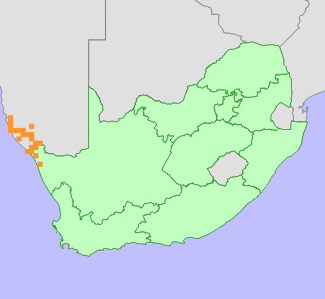|
Scientific Name | Lotononis strigillosa (Merxm. & A.Schreib.) A.Schreib. |
Higher Classification | Dicotyledons |
Family | FABACEAE |
Synonyms | Amphinomia strigillosa Merxm. & A.Schreib. |
National Status |
Status and Criteria | Near Threatened* B1ab(iii,v) |
Assessment Date | 2015/05/12 |
Assessor(s) | L. von Staden & P.C.V. Van Wyk |
Justification | A range-restricted species in South Africa (national EOO 3710 km²), but widespread in Namibia. In South Africa it is known from five to 10 locations, but may be overlooked and more common than records suggest. It is declining due to ongoing habitat loss and degradation. The South African population is continuous with the larger, stable Namibian population, and therefore the national status is downgraded by one category, following IUCN regional assessment procedures. |
Distribution |
Endemism | Not endemic to South Africa |
Provincial distribution | Northern Cape |
Range | Southern Namibia to the western Richtersveld. |
Habitat and Ecology |
Major system | Terrestrial |
Major habitats | Southern Richtersveld Yellow Duneveld, Southern Richtersveld Scorpionstailveld, Western Gariep Hills Desert, Western Gariep Lowland Desert, Western Gariep Plains Desert, Lower Gariep Alluvial Vegetation |
Description | Gravelly or sandy flats and lower slopes. |
Threats |
| On the coastal plains between Port Nolloth and Alexander Bay, as well as the lower Gariep Valley between Alexander Bay and Sendelingsdrif, this species is threatened by severe ongoing habitat loss and degradation as a result of destructive open-cast mining. Mines are not only directly destroying this species' habitat, but windblown dust from exposed mine dumps are spreading for several kilometres around the mines, burying many dwarf species. Severe overgrazing, due to overstocking of livestock, is causing ongoing degradation, loss of vegetation cover, and trampling across the western plains of the Richtersveld. |
Population |
This species is common and widespread in Namibia, but in South Africa it has a limited distribution range, and is known from only a few records. It can be abundant following good rains (P.C.V. van Wyk pers. obs.), and is possibly overlooked. It is declining due ongoing habitat loss and degradation across its range in South Africa, but the population is continuous with the Namibian population, which is not threatened.
|
Population trend | Decreasing |
Assessment History |
Taxon assessed |
Status and Criteria |
Citation/Red List version | | Lotononis strigillosa (Merxm. & A.Schreib.) A.Schreib. | NT* B1ab(iii,v) | 2015.1 | | Lotononis strigillosa (Merxm. & A.Schreib.) A.Schreib. | Least Concern | Raimondo et al. (2009) | |
Bibliography |
Raimondo, D., von Staden, L., Foden, W., Victor, J.E., Helme, N.A., Turner, R.C., Kamundi, D.A. and Manyama, P.A. 2009. Red List of South African Plants. Strelitzia 25. South African National Biodiversity Institute, Pretoria.
Snijman, D.A. 2013. Plants of the Greater Cape Floristic Region 2: The extra Cape flora. Strelitzia 30. South African National Biodiversity Institute, Pretoria.
Van Wyk, B.E. 1991. A synopsis of the genus Lotononis (Fabaceae: Crotalarieae). Contributions from the Bolus Herbarium 14:1-292.
|
Citation |
| von Staden, L. & Van Wyk, P.C.V. 2015. Lotononis strigillosa (Merxm. & A.Schreib.) A.Schreib. National Assessment: Red List of South African Plants version 2024.1. Accessed on 2025/12/24 |
 Comment on this assessment
Comment on this assessment


